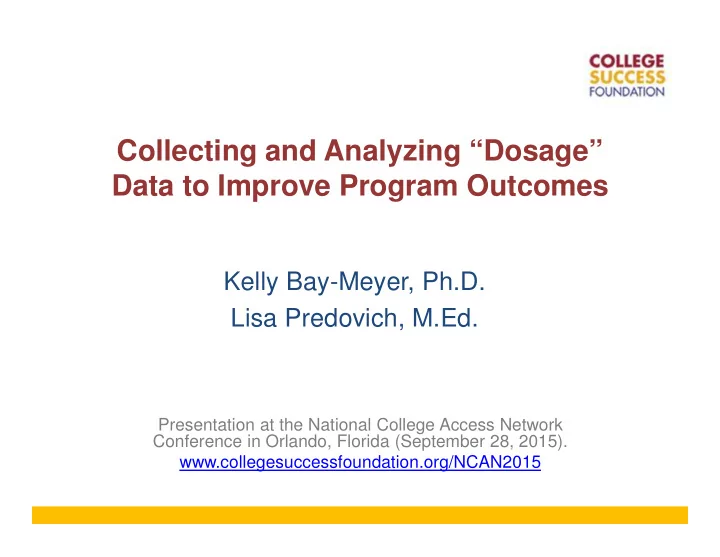

Collecting and Analyzing “Dosage” Data to Improve Program Outcomes Kelly Bay-Meyer, Ph.D. Lisa Predovich, M.Ed. Presentation at the National College Access Network Conference in Orlando, Florida (September 28, 2015). www.collegesuccessfoundation.org/NCAN2015
Agenda 15 minutes • Overview • Selecting Milestones 30 minutes • Demonstration 15 minutes • Recommendations • Reflections
Introduction to CSF Mission Statement We provide the unique integrated system of supports and scholarships to inspire underserved, low-income students to finish high school, graduate from college and succeed in life.
Introduction to CSF Focus Areas S cholarships T raining &Technical Assistance A dvocacy R esearch S tudent Supports
Dosage Data • Dosage data is defined by interactions that last longer than 15 minutes. • This data is measured longitudinally against National Student Clearinghouse data, milestone completions and student surveys to help determine how specific interventions can affect post-secondary success. • This data can be collected in an Excel spreadsheet.
Selecting Milestones 1. Program outcomes were developed based on research that demonstrated specific tasks that led to an increase in student persistence. 2. Program staff collaborated with Research & Evaluation team to build a logic model and determine methods for tracking data. 3. Realistic goals were set based on literature review.
Milestone Examples High School-Level: • Take the ACT/SAT • Apply to more than one college • File the FAFSA by the priority deadline • Participate in campus visits • Apply to more than one scholarship College-Level: • Meet with faculty during office hours • Get involved in extra-curricular activities • Participate in academic advising • Participate in early career exploration activities • File the FAFSA by the priority deadline
Dosage Data Collection & Analysis 1. Set-up Dosage Data File 2. Define Program’s Data Fields 3. Train Staff 4. Collect Dosage Data 5. Analyze Data
Demonstration Please see Dosage Data Guide & Excel template located here: www.collegesuccessfoundation.org/NCAN2015
Results Milestone Completion
Results Dosage Analysis
Results “Engaged” vs. “High Dosage”
Recommendations 1. Based on milestone completion rates, to what extent are we on track to meet programmatic goals? 2. Based on contact hours, how are students most frequently connecting with staff? 3. How do topic hours provided compare to programmatic priorities? 4. What impact might this program have on FAFSA completion?
Reflections How can collecting dosage data help improve your program?
Contact Information Kelly Bay-Meyer, Ph.D. Senior Research & Evaluation Officer, CSF kbay@collegesuccessfoundation.org Lisa Predovich, M.Ed. Senior Program Officer, Navigators, CSF lpredovich@collegesuccessfoundation.org
Recommend
More recommend